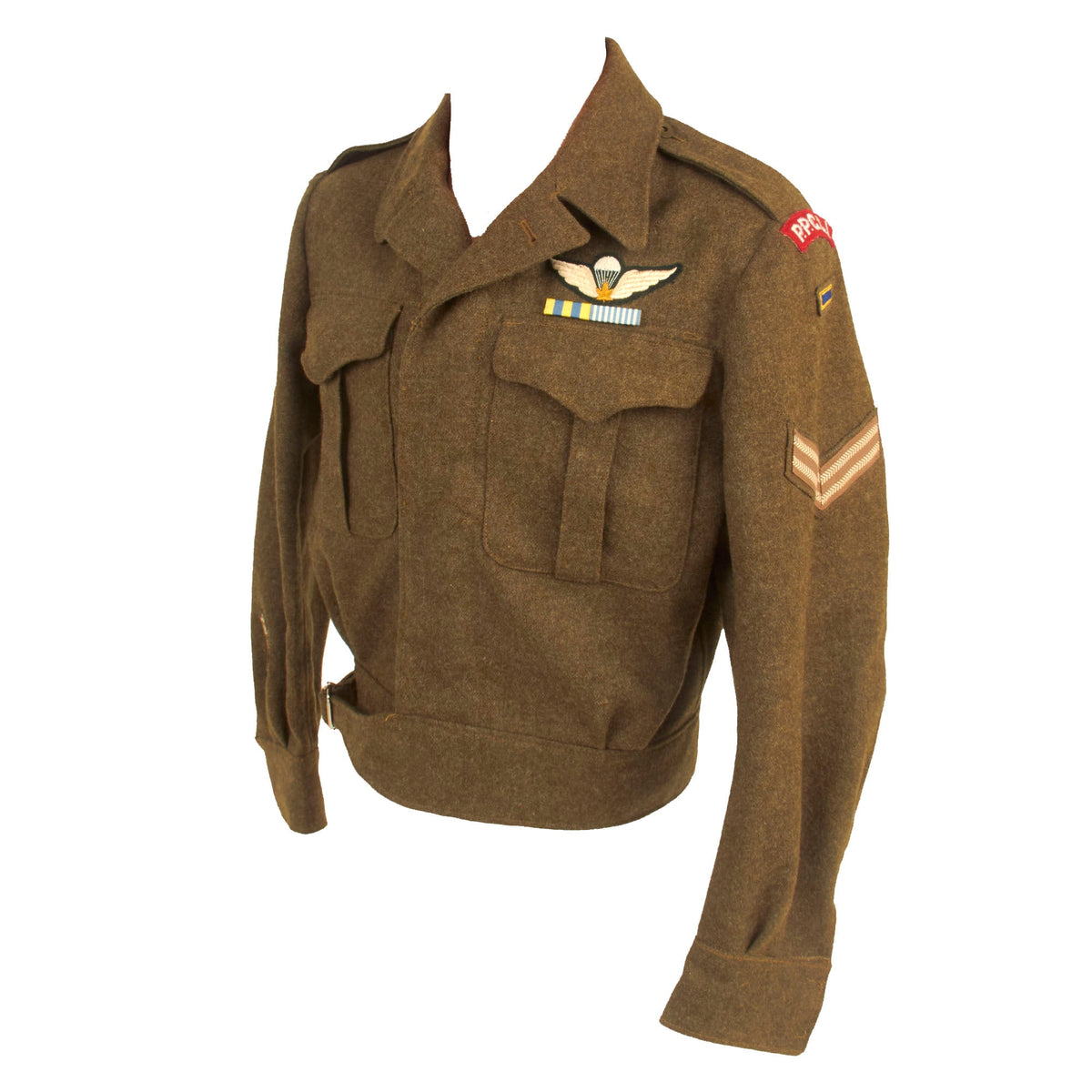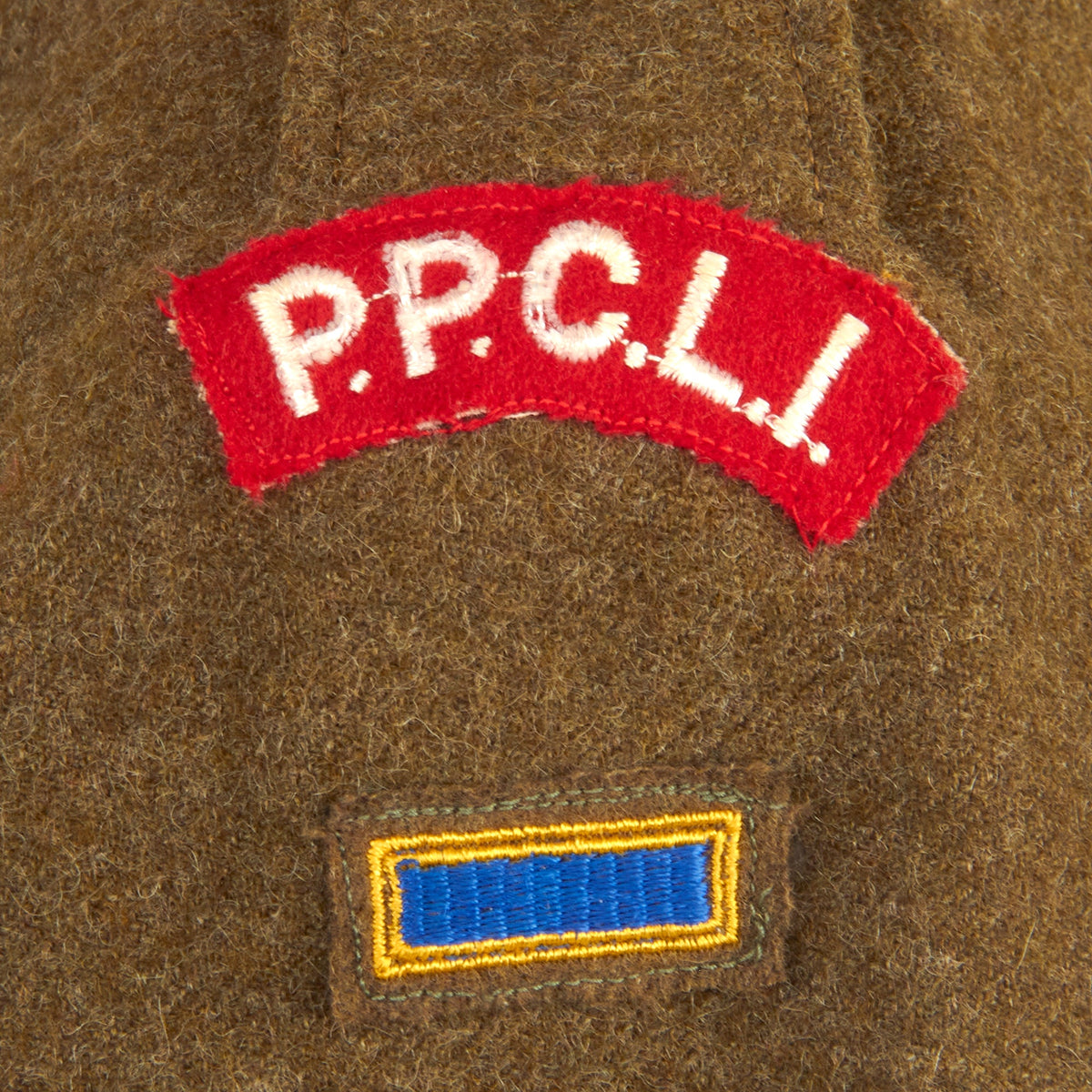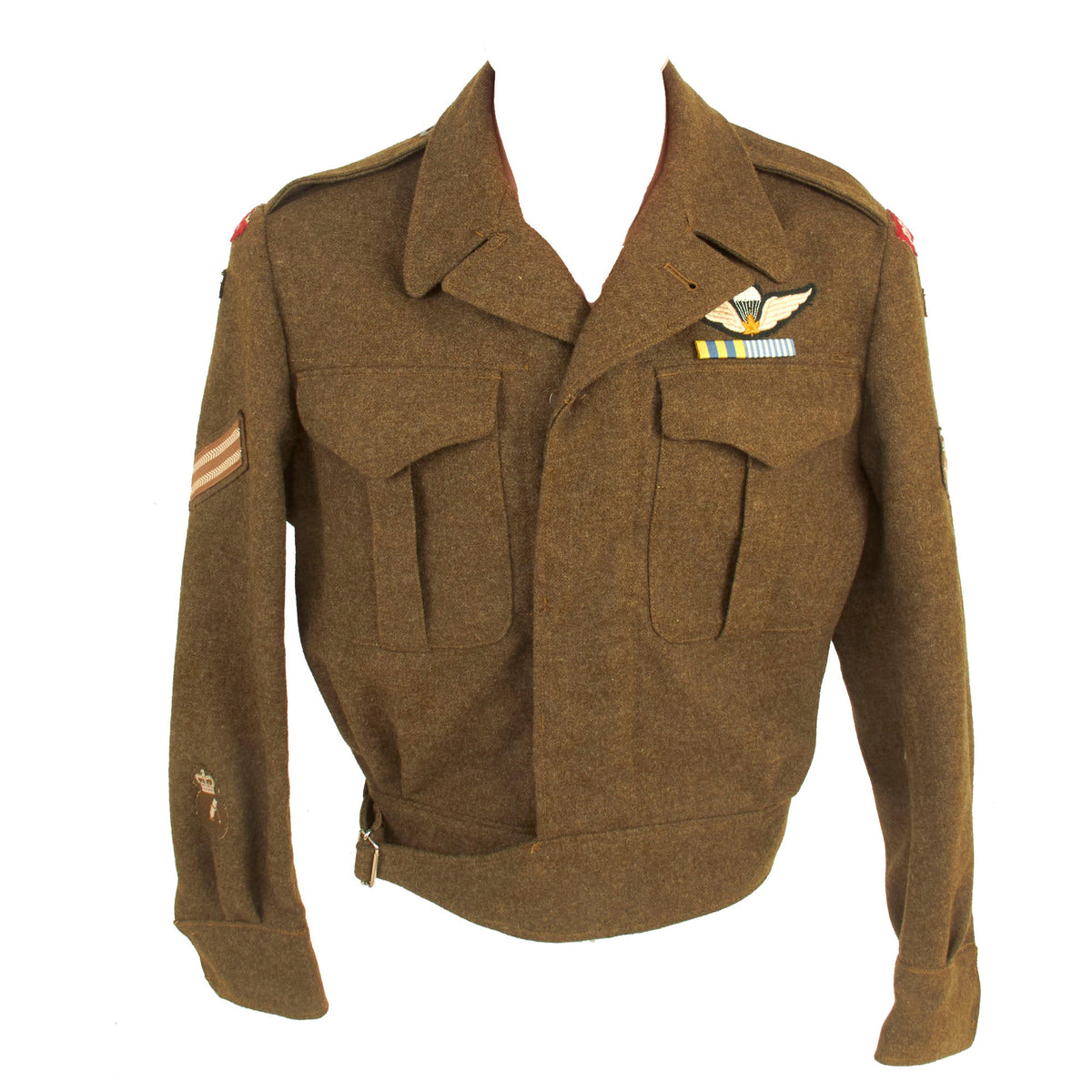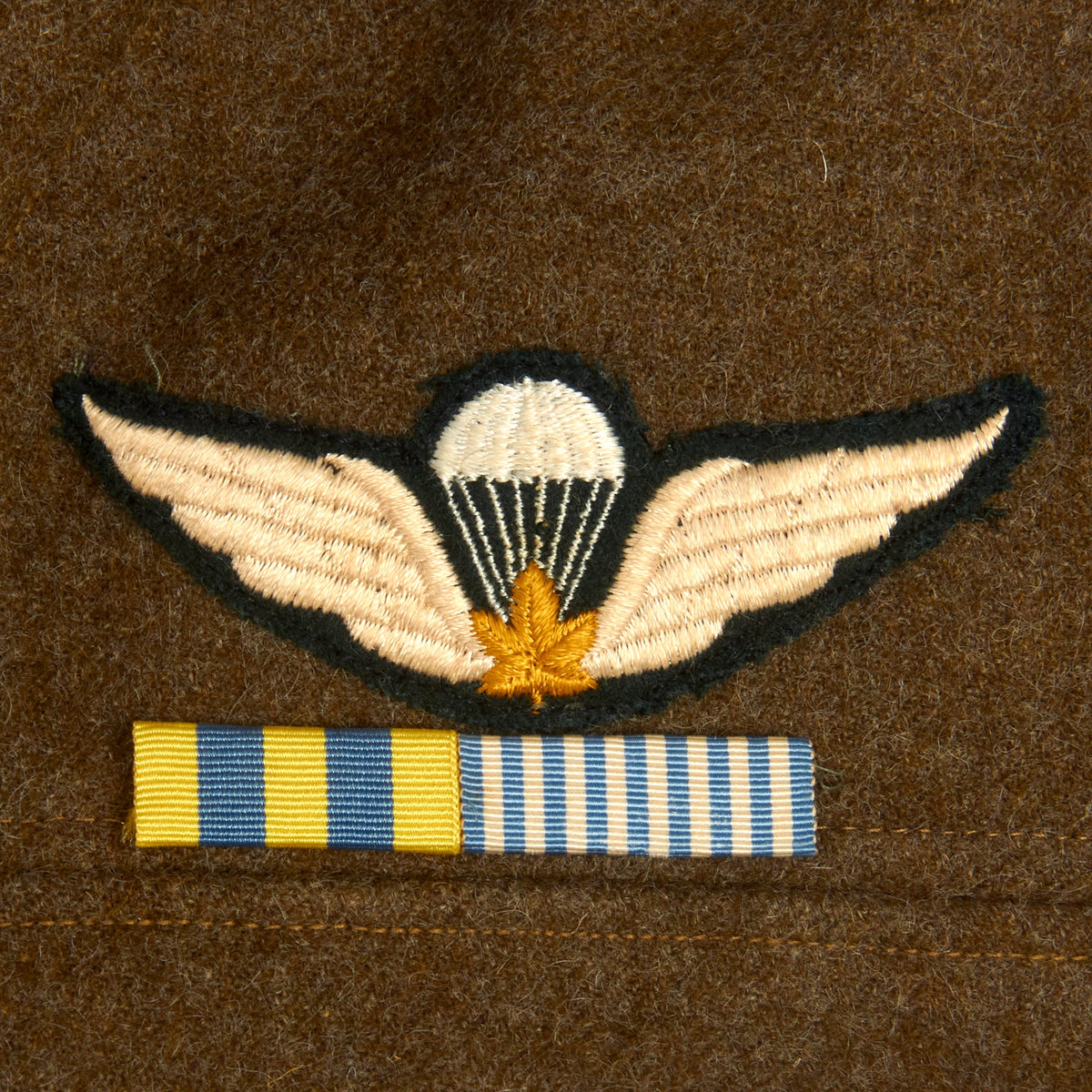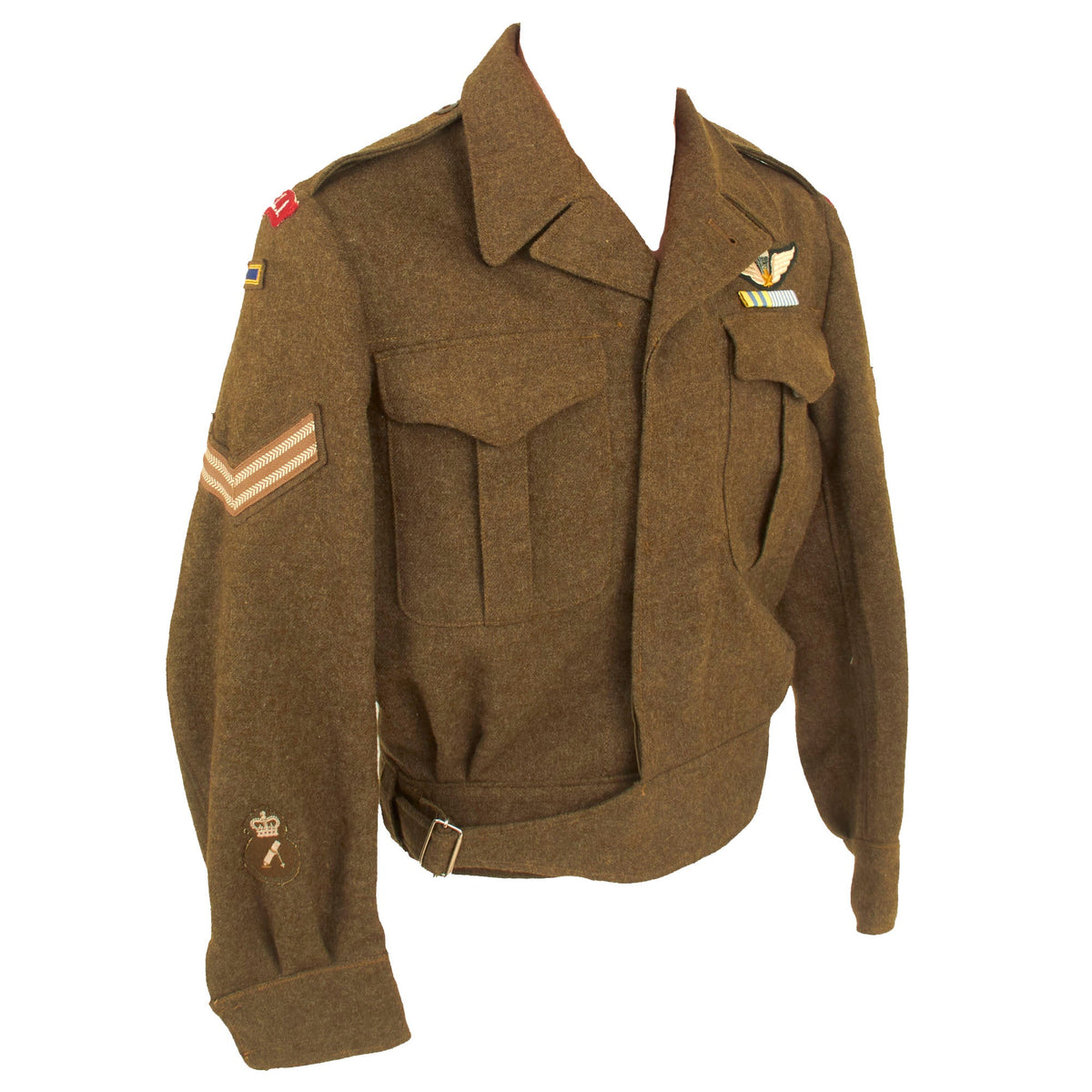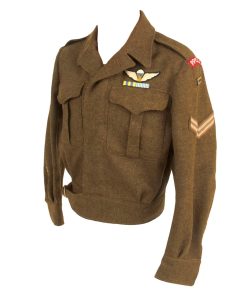Original Canadian Korean War Princess Patricia’s Canadian Light Infantry Battle Dress Jacket With Korean Made Ribbons and Period Applied Insignia Original Items
$ 295,00 $ 118,00
Original Item: Only One Available. Battle Dress was the specific title of a military uniform adopted by the British Army in the late 1930s and worn until the 1960s. Several other nations also produced variants of Battle Dress during the Second World War, including Australia, Canada, India, New Zealand, and South Africa, and after the Second World War, including Belgium and The Netherlands.
Battle Dress also inspired the military uniforms of other nations such as the United States (who copied the Battle Dress Blouse directly with the M1944 “Ike” Jacket) and Germany (whose copy of Battle Dress was called the Felduniform 44). General Eisenhower reportedly liked the British Battle Dress so much that he insisted the US copy the uniform, and his regard for the uniform led to it being nicknamed for him.
This battle dress was once worn by a member of one of Canada’s most famous infantry unit, Princess Patricia’s Canadian Light Infantry. The uniform features lovely period applied insignia consisting of:
– PPCLI shoulder rocker
– Presidential Unit Citation: Only once has the Presidential Unit Citation been publicly awarded to a Canadian unit. The 2nd Battalion Princess Patricia’s Canadian Light Infantry earned the recognition in April 1951 for their heroics in the Battle of Kapyong.
– Corporal Chevrons
– Mortar Sleeve “Trade” Patch
– Paratrooper’s Breast Badge
– Korea Medal Ribbon: The Korea Medal, sometimes referred to as the Queen’s Korea Medal to distinguish it from the United Nations Service Medal, is a campaign medal created in 1951 to recognize troops from Australia, Canada, New Zealand, and the United Kingdom who had given either one day’s service in an air sortie over Korea, or 28 days service offshore, during the Korean War. The medal was identical in all countries where it was awarded, except for Canada where it contained unique elements. An award distributed across the Commonwealth, the Korea Medal holds a different place in each country’s order of precedence for honours.
– United Nations Service Medal Korea (Ribbon): The United Nations Service Medal Korea (UNSMK) is an international military decoration established by the United Nations on December 12, 1950 as the United Nations Service Medal. The decoration was the first international award ever created by the United Nations and recognized the multi-national defense forces which participated in the Korean War.
This is a lovely uniform and comes more than ready for further research and display.
Approximate Measurements:
Collar to shoulder: 9.5″
Shoulder to sleeve: 25”
Shoulder to shoulder: 18”
Chest width: 22.5″
Waist width: 17″
Front length: 23.5″
Princess Patricia’s Canadian Light Infantry
Princess Patricia’s Canadian Light Infantry is one of the three Regular Force infantry regiments of the Canadian Army of the Canadian Armed Forces. Formed in 1914, it is named for Princess Patricia of Connaught, daughter of the then-Governor General of Canada. The regiment is composed of three battalions, for a total of 2,000 soldiers. The PPCLI is the main lodger unit of Canadian Forces Base (CFB) Edmonton in Alberta and CFB Shilo in Manitoba, and attached to 3rd Canadian Division; as such, it serves as the “local” regular infantry regiment for much of Western Canada. The Loyal Edmonton Regiment (LER), a Reserve Force battalion, is affiliated with the PPCLI but is not formally part of it. As part of this affiliation, the LER carries the designation ‘4th Battalion, Princess Patricia’s Canadian Light Infantry’.
The regiment is a “British-style” infantry regiment that is the spiritual home and repository of customs and traditions for a number of battalions that do not necessarily serve together operationally. Its three battalions are independent operational entities, under the 1 Canadian Mechanized Brigade Group (1 CMBG). Although the regimental name includes the phrase light infantry, two of its battalions are mechanized infantry, and the unit has never been organized as a traditional light infantry regiment.
The PPCLI was raised on the initiative of Captain Andrew Hamilton Gault in 1914, to participate in the Canadian war effort for the First World War. It was the first Canadian infantry unit to enter the theatre of operations, arriving in France on December 21, 1914. The regiment has also participated in the Second World War, the Korean War and the War in Afghanistan, as well as in numerous NATO operations and United Nations peacekeeping missions. The regiment has received 39 battle honours, three Commander-in-Chief Unit Commendations and the United States Presidential Unit Citation.
Korean War (1950–1954)
On August 15, 1950, the 2nd Battalion was created within the regiment to be a component of the Canadian Army Special Force in response to the North Korean invasion of South Korea; the unit adopted the designation of 2nd Battalion, Princess Patricia’s Canadian Light Infantry. The new battalion trained in Calgary and at CFB Wainwright, in Alberta, before boarding the USS Private Joe P. Martinez on November 25, 1950, to Pusan in South Korea. The battalion landed in Korea in December and trained in the mountains for eight weeks before finally taking part in the war on February 6, becoming a component of the 27th British Commonwealth Brigade of the IX American Corps in the 8th US Army. The 2nd Battalion of the PPCLI was the first Canadian infantry unit to take part in the Korean War.
On April 22, 1951, Chinese forces undertook a major offensive against the United Nations forces and pierced through the first line of defence held by the ROK Army 6th Division. During the Battle of Kapyong the 2nd Battalion, PPCLI, the 3rd Battalion, Royal Australian Regiment, and A Company, 72nd Heavy Tank Battalion (US) were tasked with the defence of the Kapyong Valley. The formation delayed the Chinese forces for three days while United Nations forces withdrew to a new defensive line, thus saving Seoul. For their action, these three units received the United States Presidential Unit Citation and the Republic of Korea Presidential Unit Citation.
On May 25, 1951, the 2nd Battalion, PPCLI was transferred to the 25th Canadian Infantry Brigade within the 1st Commonwealth Division. In the fall, the 2nd Battalion was replaced by 1PPCLI and returned to Calgary. Meanwhile, in Canada, a new battalion was created on November 30, 1950. This 3rd Battalion trained at CFB Wainwright, CFB Borden, and Camp Ipperwash, before sending troops with the 1st and 2nd Battalions during their tour in Korea.
The 3rd Battalion replaced the 1st Battalion in the fall of 1952, and occupied Hill 355 until late November 1952. After three months of active service the battalion was disbanded on February 8, 1954. The PPCLI was again reduced to two battalions, and the commander, regimental sergeant major, and members of the disbanded 3rd Battalion were chosen to form the new 2nd Battalion of the Canadian Guards.
Fast Shipping with Professional Packaging
Thanks to our longstanding association with UPS FedEx DHL, and other major international carriers, we are able to provide a range of shipping options. Our warehouse staff is expertly trained and will wrap your products according to our exact and precise specifications. Prior to shipping, your goods will be thoroughly examined and securely secured. We ship to thousands clients each day across multiple countries. This shows how we're dedicated to be the largest retailer on the internet. Warehouses and distribution centres can be located throughout Europe as well as the USA.
Note: Orders with more than one item will be assigned a processing date depending on the item.
Before shipping before shipping, we'll conduct a thorough inspection of the items you have ordered. Today, the majority of orders will be delivered within 48 hours. The delivery time will be between 3-7 days.
Returns
The stock is dynamic and we cannot completely manage it because multiple stakeholders are involved, including our factory and warehouse. So the actual stock may alter at any time. It's possible that you may not receive your order once the order has been made.
Our policy is valid for a period of 30 days. If you don't receive the product within 30 days, we are not able to issue a refund or an exchange.
You can only return an item if it is unused and in the same state as the day you received it. You must have the item in its original packaging.
Related products
Uncategorized
Uncategorized
Uncategorized
Uncategorized
Australian WWII Owen MK1 Machine Carbine SMG Custom Fabricated Replica with Sling Original Items
Uncategorized
Uncategorized
Uncategorized
Uncategorized
Armoured Fighting Vehicles of the World: AFVs of World War One (Hardcover Book) New Made Items
Uncategorized
Uncategorized
Uncategorized
Band of Brothers ORIGINAL GERMAN WWII Le. F.H. 18 10.5cm ARTILLERY PIECE Original Items
Uncategorized
Uncategorized
Uncategorized
Uncategorized
Uncategorized
Uncategorized
Angolan Rebel 1970s era 60mm Inert Display Mortar from Angolan Civil War Original Items
Uncategorized
